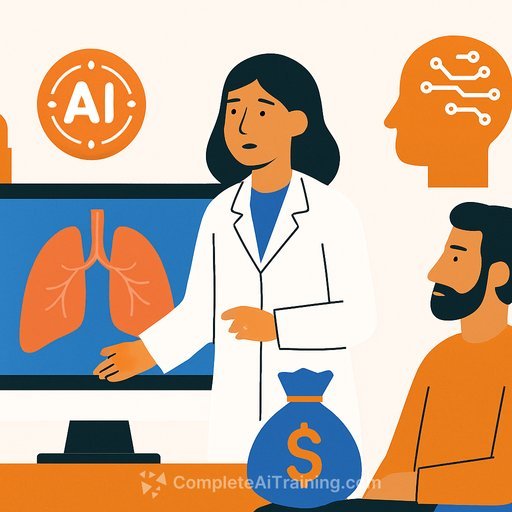Hong Kong Tech Startup Advances AI Lung Cancer Screening to Support Citywide Early Detection
Caretia, a Hong Kong Science Park-based startup, reported initial milestones for its AI lung cancer screening platform and moved into a new development phase. The update follows the 2025 Policy Address, which encouraged the launch of AI-assisted lung cancer screening across the city.
Lung cancer remains a top cause of cancer-related deaths in Hong Kong, with early stages often presenting no clear symptoms. Low-dose CT (LDCT) is proven for early detection, yet broad screening still faces cost, throughput, and access constraints.
What Caretia Is Building
The team-postgraduate researchers and graduates from The University of Hong Kong and The Chinese University of Hong Kong-has been refining an AI model over the past year to streamline LDCT screening and reduce costs. The system focuses on early lesion identification to help radiologists prioritize cases and standardize reads.
Caretia is also partnering with local charities to subsidize lung health screenings for underprivileged communities. This generates locally relevant clinical data to adapt the model to Hong Kong's population while expanding access to early detection.
"We welcome the latest Policy Address and are greatly encouraged by its focus on leveraging AI technology to enhance cancer screening and diagnosis," said Philip Tsang, Co-Founder and CEO of Caretia. "Our ongoing R&D in AI-assisted CT scan analysis is designed to identify early-stage lesions proactively. If lung cancer can be detected and treated at an initial stage, patient recovery rates can be significantly improved, while also substantially reducing public and private healthcare costs."
Tsang added that the company aims to unite local talent and deepen collaboration across government, academia, and the research community to accelerate healthcare innovation.
Why This Matters for Science and Research Teams
- Clinical need: Mortality remains high due to late diagnoses; LDCT can shift detection earlier.
- Operational bottlenecks: Screening scale requires triage, standardized reads, and QA workflows.
- Local adaptation: Training on Hong Kong data helps address population-specific features and practice patterns.
- Equity: Subsidised screening can increase participation and improve dataset diversity.
Technical and Clinical Priorities to Watch
- Validation: Prospective, multi-centre studies; sensitivity and specificity at clinically relevant thresholds; false-positive management and follow-up protocols.
- Reader studies: Impact on radiologist performance, reading time, inter-reader agreement, and recall rates.
- Generalisation: External validation across scanners, protocols, and demographics.
- Integration: PACS/RIS interoperability, structured reporting, and workflow fit for high-volume screening.
- Governance: Data security, consent, bias monitoring, and model update controls.
- Health economics: Cost-effectiveness versus current pathways, including downstream procedures.
Policy Context
With public support for AI-assisted screening, the next step is rigorous clinical evaluation and infrastructure readiness. Successful deployment will depend on clear referral criteria, quality assurance, and sustained funding for high-risk populations.
For background on LDCT screening, see the National Cancer Institute overview here. For Hong Kong incidence and trends, consult the Hong Kong Cancer Registry here.
About Caretia
Caretia is a Hong Kong startup incubated at Cyberport and now conducting AI-in-healthcare R&D at Hong Kong Science Park. The team comprises postgraduate researchers and graduates from HKU and CUHK, focusing on medical imaging and public health applications.
Practical Next Steps for Research Teams
- Define target operating points and clinical endpoints with clinicians before trials begin.
- Pre-register study protocols; include power calculations and clear inclusion criteria.
- Plan for post-market surveillance and drift monitoring once deployed.
If you're building or evaluating medical imaging models and want structured upskilling, explore role-based AI learning paths here.
Your membership also unlocks:






